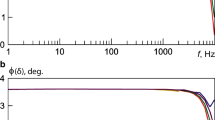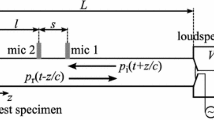The influence of the effect of heat transfer between the external environment and the air inside a cylindrical closed volume with heat-conducting walls on the acoustic impedance of the air, as well as the influence on the acoustic impedance of waves reflected from the heat-conducting and thermally-insulated walls of such volumes, was studied. A numerical algorithm based on the regularized Navier–Stokes equations with a quasi-gas-dynamic closure, taking into account the viscosity, thermal conductivity, and compressibility of air, was used in order to calculate the modulus of the complex acoustic impedance of air in a closed volume with heat-conducting walls. A good correspondence was established for the values, calculated numerically and analytically, of the modulus of the complex acoustic impedance of air in a closed volume with thermal-conducting walls. The formula for the analytical calculation of the modulus of the complex acoustic impedance of air in a closed volume with thermal-conducting walls was confirmed experimentally for infrasound and low frequencies of sound vibrations. The results of the study are relevant, both for primary calibration of measurement microphones at infrasound and low frequencies by the reciprocity pressure method and the {piston}phone method, and for the study of acoustic processes in liquid and gaseous media by numerical simulation.


Similar content being viewed by others
Change history
04 August 2023
A Correction to this paper has been published: https://doi.org/10.1007/s11018-023-02224-7
Notes
IEC 61094-2:2009. Electroacoustics. Measurement microphones. Part 2. Primary method of calibration based on pressure of laboratory reference microphones by the mutual information method.
References
S. Ballantine, J. Acoust. Soc. Am., 3, No. 8 (1933); https://doi.org/10.1121/1.1901925.
F. B. Daniels, J. Acoust. Soc. Am, 19, No. 4, 569–571 (1947), https://doi.org/10.1121/1.1916522.
I. G. Rusakov, Thermodynamic correction to the pump method, T. Commiss. Acoust., 8, 76–81 (1955).
M. D. Burkhard, F. Biagi, R.K. Cook, E.L.R. Corliss, and W. Koidan, J. Acoust.. Soc. Am, 26, No. 5, 935 (1954), https://doi.org/10.1121/1.1927953.
H. Gerber, J. Acoust. Soc. Am, 36, No. 8, 1427–1434 (1964), https://doi.org/10.1121/1.1919219.
E. Frederiksen, Reduction of heat conduction error in microphone reciprocity pressure calibration, Bruel and Kjaer Tech. Rev., No. 1, 14–23 (2001).
P. Vincent, D. Rodrigues, F. Larsonnier, et al., Metrologia, 56, No. 1, 015003 (2019), https://doi.org/10.1088/1681-7575/aaee28.
K. N. Volkov, Yu. N. Deryugin, V. N. Emel’yanov, et al., Methods of Acceleration of Gas-Dynamic Calculations on Nonstructured Networks, FIZMATLIT, Moscow (2014).
I. V. Abalakin, V. G. Bobkov, and T. K. Kozubskaya, "Development of a computational method for currents with a small Mach number on unstructured networks in the NOISEtte software package," Mat. Mod., 29, No. 4, 101–112 (2017), https://doi.org/10.1134/S2070048217060023.
E. Turkel, Annual Review of Fluid Mechanics, 31, 385–416 (1999), https://doi.org/10.1146/annurev.fluid.31.1.385.
A. J. Chorin, J. Comput. Phys., 2, No. 1, 12–26 (1967), https://doi.org/10.1016/0021-9991 (67)90037-X.
S. E. Rogers, D. Kwak, and C. Kiris, AIAA J., 29, No. 4, 603–610 (1991), https://doi.org/10.2514/3.10627.
S. E. Rogers and D. Kwak, Appl. Num. Math., 8, No. 1, 43–64 (1991), https://doi.org/10.1016/0168-9274(91)90097-J.
P. L. Roe, J. Comput. Phys., 43, No. 2, 357–372 (1981), https://doi.org/10.1016/0021-9991 (81) 90128-5.
F. Rieper, J. Comput. Phys., 230, No. 13, 5263–5287 (2011), https://doi.org/10.1016/j.jcp.2011.03.025.
X.-S. Li and C.-W. Gu, J. Comput. Phys., 227, No. 10, 5144–5159 (2008), doi.org/https://doi.org/10.1016/j.jcp.2008.01.037.
M.-S. Liou and C. J. Steff en, J. Comput. Phys., 107, No. 1, 23–39 (1993), https://doi.org/10.1006/jcph.1993.1122.
M.-S. Liou, J. Comput. Phys., 129, No. 2, 364–382 (1996), https://doi.org/10.1006/jcph.1996.0256.
M.-S. Liou, J. Comput. Phys., 214, No. 1, 137–170 (2006), https://doi.org/10.1016/j.jcp.2005.09.020.
V. A. Balashov and E. B. Savenkov, A numerical study of a quasihydrodynamic system of equations for the computation of currents with a small Mach number, Zh. Vych. Mat. Mat. Fiz., 55, No. 10, 1773–1782 (2015), https://doi.org/10.7868/S0044466915100063.
D. V. Golovin, Simulation of an infrasound pistonphone, Tr. Inst. Sist. Prog. RAN, 32, No. 5, 181–198 (2020), https://doi.org/10.15514/ISPRAS-2020-32(5)-14.
D. V. Golovin, Numerical simulation of sound pressure for a system of calibrating LS-type measurement microphones, Mat. Mod., 33, No. 10, 96–108 (2021), https://doi.org/10.20948/mm-2021-10-07.
T. G. Elizarov, Quasi-Gas Dynamic Equations and Computational Methods of Viscous Flows, Nauchnii Mir, Moscow (2007), https://doi.org/10.1007/978-3-642-00292-2.
Yu. V. Sheretov, Dynamics of Continuous Environments with Space-Time Averaging, Moscow, Izhevsk (2009).
Acknowledgment
The author is deeply grateful to Tatiana G. Elizarova (Keldysh Institute of Applied Mathematics of the RAS) for support and advice in conducting this research.
Author information
Authors and Affiliations
Corresponding author
Additional information
Translated from Izmeritel’naya Tekhnika, No. 11, pp. 65–71, November, 2022.
Rights and permissions
Springer Nature or its licensor (e.g. a society or other partner) holds exclusive rights to this article under a publishing agreement with the author(s) or other rightsholder(s); author self-archiving of the accepted manuscript version of this article is solely governed by the terms of such publishing agreement and applicable law.
About this article
Cite this article
Golovin, D.F. Modulus of Complex Acoustic Impedance of Air in a Cylindrical Closed Volume: Calculation Using Numerical Simulation. Meas Tech 65, 858–865 (2023). https://doi.org/10.1007/s11018-023-02161-5
Received:
Accepted:
Published:
Issue Date:
DOI: https://doi.org/10.1007/s11018-023-02161-5




